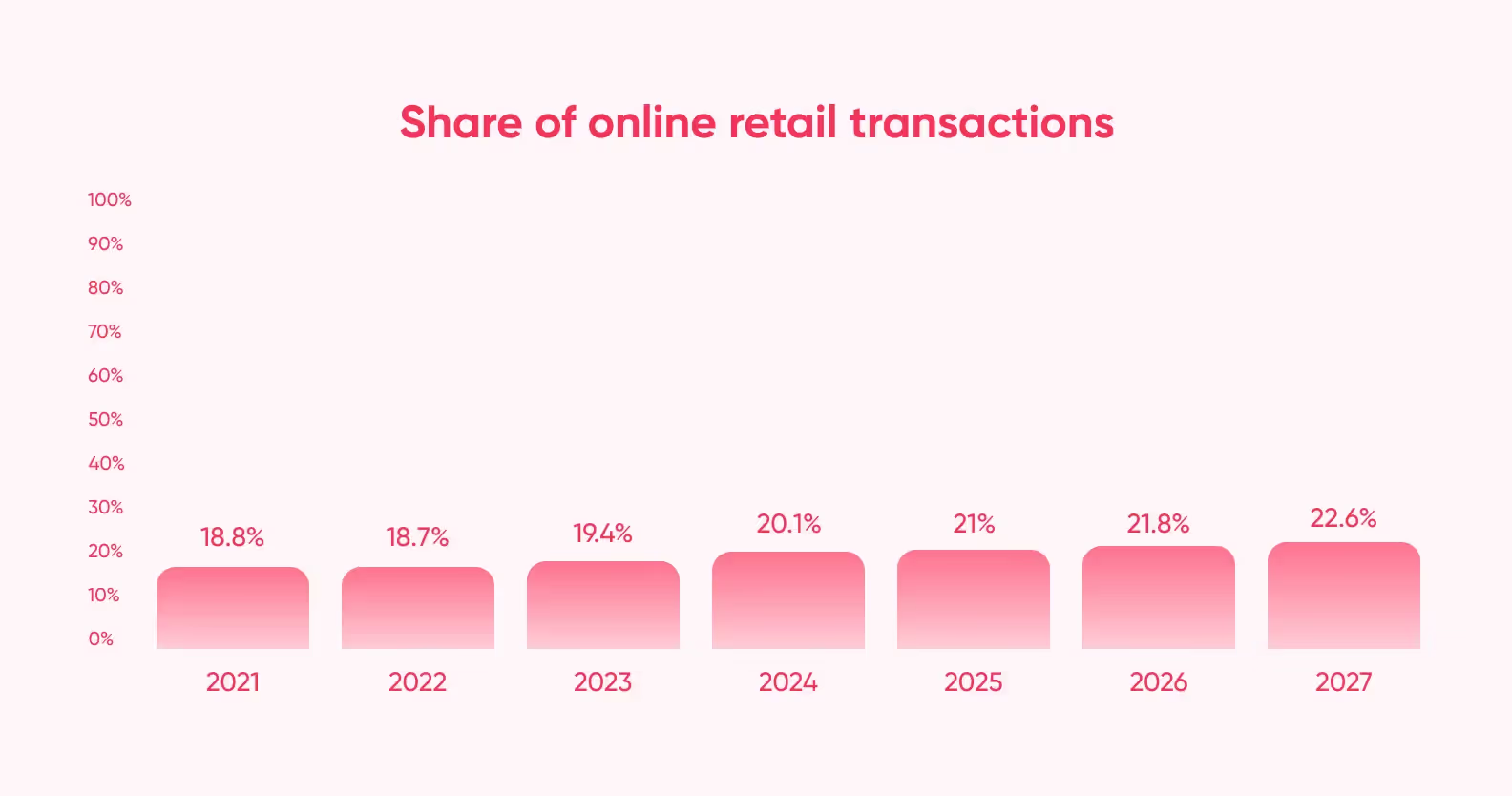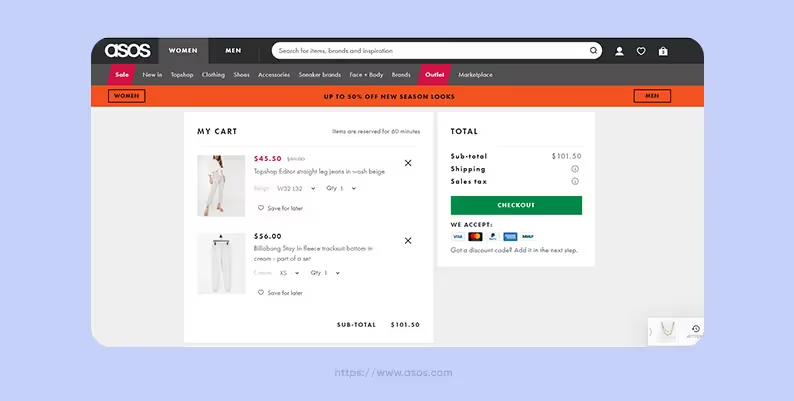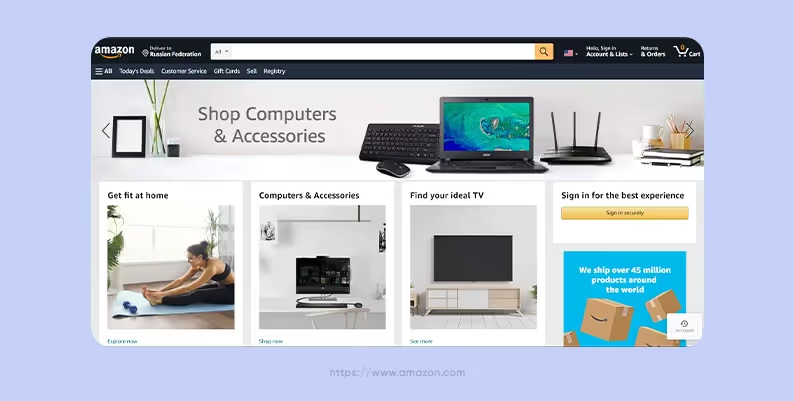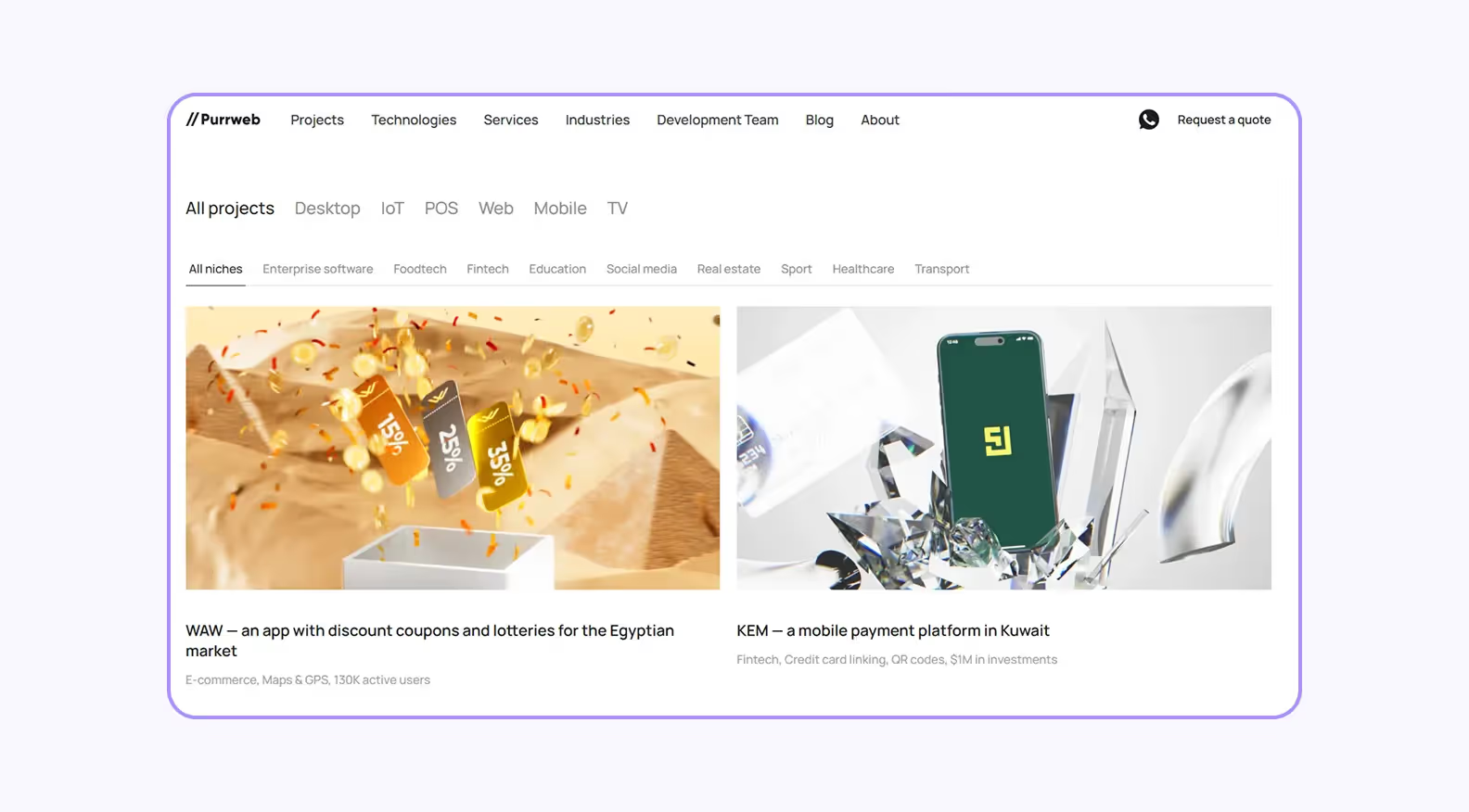


We are used to shopping on marketplaces, and the statistics confirm this fact — 2.77 billion people make online purchases. It's convenient, you don't have to leave your home, catalogs offer products from different categories, and platforms are available 24/7. Given these advantages, the idea of creating your own platform definitely seems appealing. However, the market is competitive, and investments in development may not pay off.
In this article, we’ll examine the current market state and discuss the cost of creating your own marketplace. We’ll list the factors that impact the budget and explain how to reduce marketplace development costs.
.avif)
There are approximately 28 million e-commerce websites on the market, half of which are registered in the US. Shopify leads with a 24% share of the global market, followed by Wix with 23%. However, according to DigitalCommerce 360, China has the highest concentration of sales. Three platforms — Taobao, Tmall, and JD.com — account for 62% of third-party (3P) sales.
Statista reports that 2.77 billion people, nearly a third of the world’s population, currently shop online. This figure is expected to reach 2.86 billion by 2026, with the share of online sales in total purchases increasing from 21% to 22.6%.

Buyers are becoming increasingly active. One-third of users make online purchases every week, and 99% read reviews before placing an order. This indicates that e-commerce has already become the primary sales channel.
There are 6 factors to consider before starting a project.
There are special marketplaces, such as CodeCanyon and Flippa, where you can buy ready-made applications and templates. Alternatively, you can purchase a white-label product from a development company or a business from your niche. This way, you won’t have to spend your budget on hiring a team or time on development. All you have to do is purchase a license and customize the application according to your needs.
However, you won’t be able to add business-specific features with these applications. You’ll also depend on the vendor, who may stop providing updates and increase the cost of the license.
On the other hand, there is custom marketplace development. Development teams create products from scratch — select references, create designs, develop features, and launch the platform. Therefore, this path is more expensive, but you’ll have complete control over the project's progress.
You can create a web version. The cost of building a marketplace website is less than creating a mobile app because web browsers are available on a variety of devices and operating systems. The development process is also shorter. The team doesn’t need to create separate versions for phones and computers. They only need to build adaptive designs.
Since web apps are hosted on web servers, users see updates immediately after their implementation. With mobile applications, however, updates must be downloaded through app stores. This takes more time and requires additional effort.
Nevertheless, you can develop a mobile application to provide convenience for mobile device users. There are two types of mobile applications: native and cross-platform.
Native applications have a separate code base for each platform. For example, developers use Swift/Objective-C for iOS and Java/Kotlin for Android.
Cross-platform applications have a single code base for multiple platforms. Here, developers use React Native and Flutter.

Native apps are more expensive than cross-platform apps because they require twice as much work, both during development and after release. Updates and patches must be rolled out separately for each platform. However, native apps are ideal for complex projects that require maximum performance and full access to hardware features.
Cross-platform applications are ideal for projects with limited budgets and for those that require rapid market entry. For example, React Native reduces development time and costs by 30%. Popular marketplaces that use cross-platform frameworks include Airbnb, Walmart, and Alibaba.
The more features an app has, the more work it’ll need, and the higher the cost. Each feature needs to be designed, developed, and tested.
Marketplace apps with basic features, such as registration, user profiles, product catalogs, and shopping carts, are less expensive. Their development is standard because developers use proven approaches and libraries. The cost of these apps depends on the number of screens and the design’s complexity.
Advanced features for marketplaces include monetization, personalized content, multi-currency payments, and order tracking. Developing them takes more time and requires specialized knowledge.
In order to create an interface that suits the business and appeals to users, designers examine the market. They analyze competitors and collect positive and negative references.
If there are doubts about style or user response, business analysts will conduct separate research. The team interviews the target audience to find out their preferences.
After releasing the app, consider the costs of refining and improving screens based on user feedback.
If you want to save money, you can use template solutions available online. However, customization for unique features may be limited, and adaptation to devices and resolutions may be poor. In addition, the necessary screens may be missing.
There are three ways to develop a project: in-house, hiring freelancers, and outsourcing.
In-house. With this approach, you build your own team of managers, developers, designers, and testers. This approach is suitable if you have the resources to hire employees and aim to create a full-fledged product right away. The team will actively participate in the project, and you’ll have full control over the development process. Be prepared for high fixed costs and a lengthy hiring process.
Freelancers. This type of hiring is ideal for specific tasks. Freelancers are a good fit for companies that are developing an MVP or looking to fill a vacant position. They can easily be brought into projects, but there’s a risk that they'll violate the NDA or stop communicating.
Outsourcing. You hire an external team to help turn your idea into a finished product. This is the go-to option if you need to launch a project quickly or have a limited budget. Before you start working together, it’s important to thoroughly research the agency and talk to the team. This way, you can make sure they align with your values and expectations.
Since marketplaces interact with users’ financial data, it’s crucial to ensure the security of the platform. This involves complying with regulations and legal requirements, as well as strengthening technical security. All of this takes time and requires financial investment.
Businesses must study the legal aspects of handling personal information in advance. For example, the European Union has the General Data Protection Regulation (GDPR), which provides guidelines for collecting, processing, storing, and distributing personal information. This regulation affects all businesses that work with the data of EU citizens.
Additionally, there is the PCI DSS standard, which ensures the confidentiality and security of cardholder information. It includes 288 verification criteria covering software and monitoring. Companies must undergo certification once a year.
Failure to comply with the regulations will result in legal penalties and a loss of reputation. Therefore, you must implement security measures in your marketplace:

The legal requirements for interactions with users and business partners can affect the platform's logic. Therefore, the business must draw up the following documents with a lawyer:
Marketplaces can be classified by the type of goods sold, the participants involved, and the field.
In terms of their internal structure, marketplaces can be either vertical or horizontal.
Vertical. The marketplaces present goods/services in a specific category or narrow niche. They focus on providing an in-depth and detailed presentation of a single category of goods/services.
Horizontal. These marketplaces offer a wide variety of goods and services from different categories. Their strategy is to attract as many buyers as possible by offering a variety of products.
We can divide marketplaces into three types based on their participants:
B2B. Here, companies act as both sellers and buyers. For example, owners of shops, restaurants, construction companies, and factories. These businesses purchase goods in large quantities — materials, equipment, and office supplies — or order specialized services.
B2C. This is the format we are most familiar with. Here, stores, brands, or businesses, sell their goods and services to consumers. You use the platforms to buy something specific: a phone, a book, clothes, food, cosmetics, or movie tickets.
C2C. This is like a flea market or bulletin board. Here, people sell things they no longer need or offer their services. These can be used goods, such as clothing, appliances, furniture, children’s items, collections, and handmade items.

Based on the type of goods offered, marketplaces are divided into four types:
Information. These platforms collect and provide information. They don't sell goods or services directly, but rather act as catalogs, helping users find what they need and contact suppliers. For example, a user looking for a job or planning to buy an apartment could use one of these platforms. The development of this platform can cost $65,000.
Goods and products. This is a common type of marketplace where large stores and individuals sell physical goods. Users visit the marketplace, select the item they need, place an order, and receive their purchase. The platform's job is to provide convenient searches and secure transactions, taking care of payment and logistics issues. The marketplace development cost is $90,000.
Services. The marketplaces connect people who need services with those who provide them. Users pay for the result of the work, experience, or temporary use of something. This could be a taxi ride, hotel accommodation, apartment renovation, design development, or tool rental. You can expect to pay $75,000 for the development of the service platform.
Investment and fundraising. On these platforms, users invest and raise capital for their projects. Later, investors receive the completed project/reward, a financial return with interest, or a share in the business. The marketplace app development cost is $80,000.
It is a matter of fact that every marketplace is unique but there is a range of features that have to be there. You may have a great idea and inspiring purpose but if it's poorly developed, it won’t succeed and your investments won’t pay off.
These are basic features that every marketplace cannot exist without: :
Onboarding. Tell your users how to navigate your app. Do not forget to categorize your users and show them tips according to whether they sell or buy. Articles and FAQ sections are a must.
Personal profile and profile statistics. Personal profiles are needed so people have more confidence in your marketplace. If a buyer sees a seller, his reviews, and other products, they are more likely to buy from them because of credibility. Sellers will be able to show-off their ratings and analyze how successful their profile is and whether they need to fix something to get more deals.

Easy-to-use settings. Every user tries to customize an app to their liking. They want to be in control of data and storage use, notifications, etc. You have to give them access to doing so without little or no effort on their side. Otherwise, they can become irritated and delete the app at once.
Categories. If you did not choose a very specific niche, categories are a must. It is beneficial for both users and sellers. Users will be able to navigate around the app easily. At the same time, they do not type in a specific product so they can see other products in the category and buy more than they intended which is good for sellers.
Detailed product profiles. Sometimes users do need a specific product so they want to find it by using keywords. They may look for a specific color, size, travel destination, year of rolling out — it depends on your niche. Detailed profiles can help them with that. Moreover, detailed profiles are more credible and users do not have to text a seller every time they want to know a detail about the product.
Shopping cart and payment gateway. Shopping carts and payment gateway are essentials of every marketplace. Basically, it is what the marketplace is for. Shopping carts are specifically useful if you need to buy more than one product or you are deciding on what to take. Payment gateway makes your marketplace reliable and secure. It prevents any credit card data leakage and mediates between the bank and the marketplace.

Order status and confirmation. Users naturally want to know what is happening to their order and track down if it was lost somewhere in the process. Knowing every step that your order is going through is yet another addition to the feeling of security.
Let’s look how much it costs to develop each of these features:
Optional features are not that necessary but they will make you stand out among your competitors and ensure the best customer experience resulting in traffic.
A marketplace prototype is a draft or several drafts that do not require much effort. It is a stage where you try different things. Prototypes can be changed and adapted in the process.
MVP (Minimum Viable Product) requires more effort and one idea. That’s a working product with only essential features that would help you see its potential, as you would be able to analyze how well users react to your product, how they behave on it and whether or not they are willing to pay for it. In the course of enhancing the MVP, you can change what users do not like and add more features if you see that it would improve their experience.
After you have already designed an MVP and you think that everything looks fine and contains all the features that you want the marketplace to have, it is essential that you see how it works from the technical side. You have to test all the possible scenarios and fix any issues that may occur. Of course, it may happen that you do not see all the issues – you will fix them later – but you have to do your absolute best.
After the feature set, UI/UX design and tech are proved to be fine, it is time to launch the app.

As we have stated before, you cannot see all the bugs during testing. Only when the product is used, you can see the whole picture. It is the time when you collect feedback about any bugs or the possibility of adding the lacking features. You have to be very attentive to what starting users are saying because if you do not fix that now, you will not grow popular or the system that is not working with little users may collapse when there is a lot.
After you have collected the feedback and fixed all that needed to be fixed, you can show your polished shiny version of the marketplace to everyone on the Internet. However, try to listen and improve as your customer base grows. There are no limits to perfection.
The final cost of creating an online marketplace depends on how well you prepare. Thorough planning in the early stages will help you avoid unexpected expenses.
Before beginning development, it's important to understand who the application is for and what tasks it'll perform. Identify your target audience, analyze your business model, and study similar projects. Make a list of features that will benefit users.
This preparation will save time and money by eliminating unnecessary meetings and revisions. The clearer your vision of the end result, the more efficient and faster the work will be.
Before creating an app, determine if users really need it. Conduct a discovery phase by surveying potential customers and assessing profitability. Create a landing page to promote your project and analyze how many people are interested.

It’s cheaper to research an idea than to develop and launch an app. If the product is unpopular, you can adjust or change the concept without additional development costs.
If you decide to outsource development to a company, it's worth taking the time to find the right one. This will help you avoid future rework and unnecessary expenses.
What to look for when searching for a company:
Portfolio. It’ll give you an idea of the agency's style, quality, and variety of work. Look for projects in your niche. If the agency has successfully completed similar projects, they'll be able to do the same with yours.

Reviews. Feedback from clients reveals information about the agency's work and problem-solving abilities. Pay attention to both positive and negative reviews. However, keep in mind that reviews are easy to edit and fake. If there are video reviews on the website, focus on them.
Work process. Find out on the website or at the first meeting how the agency organizes its workflows. If the agency values transparency, it'll offer a clear plan with defined stages. It's important that the team gives you the opportunity to express your preferences and make changes throughout the process.
A minimum viable product is a basic version of an application with only the essential functionality. Developing an MVP is cheaper and faster than creating a full-fledged product. This enables you to attract your first users, collect their feedback, and determine how to further develop the application. If the idea doesn't take off, you can always change the course without significant financial loss.
Building a successful marketplace app is not easy, quick, and cheap. It heavily depends on what kind of result you want to get: is it a luxurious marketplace with augmented reality or is it something simpler?
In terms of time that is needed, you will need:
At Purrweb, we choose React Native as a framework for marketplace app development, as it allows us to develop one code for both iOS and Android. This significantly saves the client’s time and money while allowing them to see the full potential of the business idea.
So, how much does it cost to build a marketplace website or app? Here are our rates and timeframes of marketplace app development:
Overall, you will need $75,000-$90,000 to launch your own marketplace. And developing an application will take approximately 20 weeks, which equals 5 months.
Marketplace app development is a big project that requires time, effort, money, and patience. You have to plan in advance the idea of your marketplace and features that you want to add, then you have to go through rounds of prototypes and MVP creation, testing, constant improvement of the platform, and marketing process.
The marketplace app is not cheap and you have to put effort into it even after the development stage is over. However, it is a huge business idea that can bring you incredible profit in the long run.
➡️ Want to develop a custom marketplace? <a class="blog-modal_opener">Contact us</a>, we'd be happy to help! We’ll study your business processes, determine your needs, and begin the development.